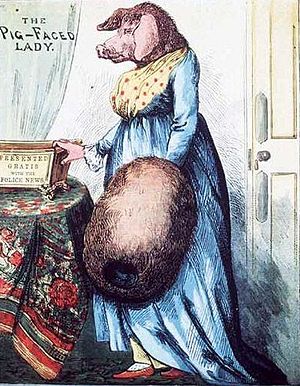
Back ذوات وجه الخنزير Arabic Schweineköpfige Frauen German Mujer con cara de cerdo Spanish Wanita berwajah babi ID Donna dal muso di maiale Italian 豚顔の女性 Japanese Wanita rai babi JV 돼지 얼굴 여인 Korean Свинорылые женщины Russian 猪脸女 Chinese

Legends featuring pig-faced women originated roughly simultaneously in The Netherlands, England and France in the late 1630s. The stories tell of a wealthy woman whose body is of normal human appearance, but whose face is that of a pig.
In the earliest forms of the story, the woman's pig-like appearance is the result of witchcraft. Following her wedding day, the pig-faced woman's new husband is granted the choice of having her appear beautiful to him but pig-like to others, or pig-like to him and beautiful to others. When her husband tells her that the choice is hers, the enchantment is broken and her pig-like appearance vanishes. These stories became particularly popular in England, and later in Ireland.
The magical elements gradually vanished from the story, and the existence of pig-faced women began to be treated as fact. The story became particularly widespread in Dublin in the early 19th century, where it became widely believed that reclusive 18th-century philanthropist Griselda Steevens had kept herself hidden from view because she had the face of a pig. In late 1814 and early 1815, rumour swept London that a pig-faced woman was living in Marylebone. Her existence was widely reported as fact, and numerous alleged portraits of her were published. With belief in pig-faced women commonplace, showmen exhibited living "pig-faced women" at fairs. These may have not been genuine women, but shaven bears dressed in women's clothing.
Belief in pig-faced women declined, and the last significant work to treat their existence as genuine was published in 1924. Today, the legend is almost forgotten.